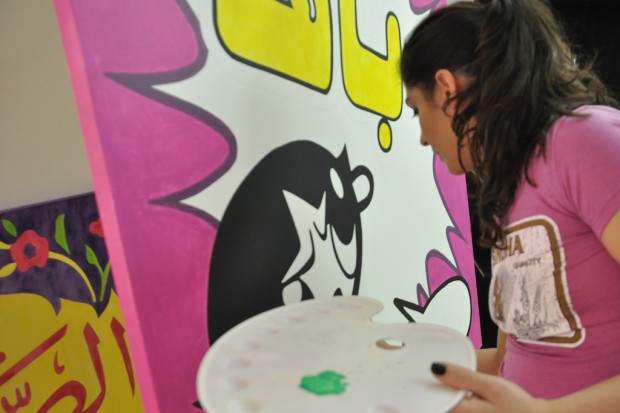
An offspring of varied cultures, Saudi-Arabia-based artist, Corinne Martin interprets iconography of contemporary Arab pop culture derived from television, music, food, and fashion through her mixed media and paintings. Her inherently colorful work is distinctly fresh and yet undeniably also exudes a vintage quality, evoking nostalgia for the past while very much being of the present. She’s also very interested in the notion of the region being a meeting point between Western and Eastern sensibilities and the role globalization plays amidst that.
Khaleejesque spoke to Corinne to find out more about her inspirations and motivations..
 You've lived and studied in a variety of places, such as Lebanon, the United States, and Saudi Arabia. Have the experiences of living in several places impacted your art or does it arise from a completely independent space within you?
You've lived and studied in a variety of places, such as Lebanon, the United States, and Saudi Arabia. Have the experiences of living in several places impacted your art or does it arise from a completely independent space within you?
I was born in Paris, raised in Beirut, studied in Houston, and now live in Riyadh. The experience of these diverse cultures gives me an appreciation for the nostalgic nature behind each culture's location. After returning to the Middle East, I was able to experience my roots both as an adult and as an artist from a fresh perspective. The region is experiencing immense cultural growth and has a new, rejuvenating energy that inspires and infuses my work. I love visiting the supermarket and looking at the different products rendered in Arabic script and noting that how they can take on completely different meanings being depicted in an alternate language with its attendant visual and cultural associations.
How has studying Graphic Communications and Art History inspired and informed your art?
Yes, my education in Graphic Communications and Art History greatly contributed to my awareness of these icons and their impact on each culture, particularly through studying typography, color, and the evolution of art and design through time.
You've taken symbols of Arab pop culture and represented them in your unique way. What personal significance do these icons of Arab popular culture hold for you? What do you bring to these icons as an artist?
I’ve always drawn inspiration from those iconic images as they reflect the experiences of a younger generation of Arabs who came of age between the East and West. It’s a reflection of what we grew up watching on television, the music we listened to and even, the food we ate. All of these aspects have shaped our visual culture, which is why that kind of art resonates with so many people as it has an emotional connection to their past. I also explore the affects of globalization on the Middle East and in particular how it’s changed the lives of young women coming of age in the Arabian Gulf region.
 Many of your paintings and photographs focus on popular soft drinks and food items with you choosing to depict their names in the Arabic script. Yet, someone unfamiliar with the Arabic script is still nevertheless able to recognise the icons of Pringles or Pepsi. Are you making a statement on globalisation through the way icons form a global visual language of their own?
Many of your paintings and photographs focus on popular soft drinks and food items with you choosing to depict their names in the Arabic script. Yet, someone unfamiliar with the Arabic script is still nevertheless able to recognise the icons of Pringles or Pepsi. Are you making a statement on globalisation through the way icons form a global visual language of their own?
Everybody has similar experiences regardless of where they live in the world. I think the meeting of East and West is a positive step for the Middle East because the East has strong, defined visions about what they want to achieve and possess the requisite financial capabilities while the West in turn provides the tools and progressive ideology to realise those visions. My work is therefore an organic blending of East and West. My Middle Eastern roots feed my passion and creativity while my Western roots have equipped me with the skills to respond to and express the latter.
Your paintings have a fruity color-palette to them which evoke a distinct freshness. Could you tell us about your paintings and your stylistic and thematic approach towards them?
I love color. It breathes life and energy into a space. In regards to my technique, I continuously experiment with different techniques and surfaces.
Your work has been displayed in boutiques such as DNA Boutique in Riyadh, creating a wonderful synergy with the retail items. What do you think of displaying your work in boutiques as opposed to more conventional art spaces such as galleries?
I like placing my paintings in boutique and retail spaces because they feed off the products displayed around them and that in turn imbues them with an even more vibrant personality.
– Priyanka Sacheti
Find out more about Corinne Martin’s work at http://work.corinnemartin.com/







